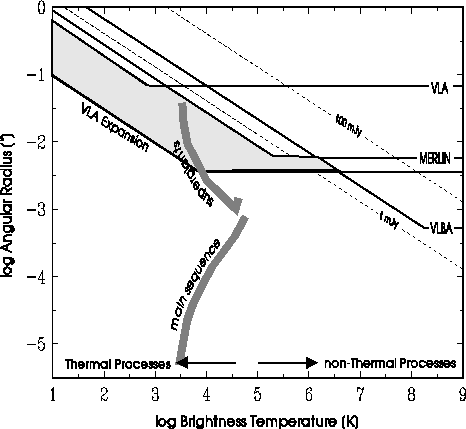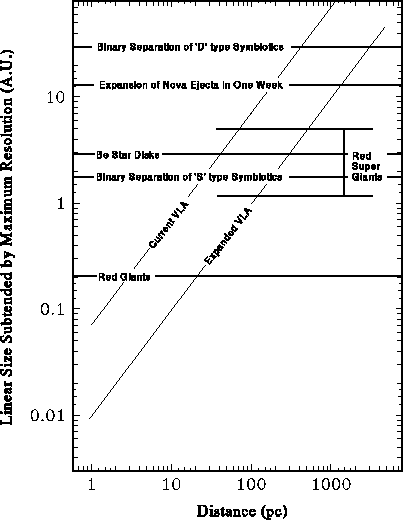IMAGING THERMAL EMISSION




Next: CIRCUMSTELLAR MASERS
Up: THE MILKY WAY
Previous: STELLAR ASTROMETRY
The combination of the upgrade in sensitivity and the
increased angular resolution provided by the A+ configuration opens an
extremely exciting area of investigation that cannot be exploited by
any other existing or planned instrument - milli-arc-second resolution
imaging of thermal radio emission. This capability is placed in
context in the angular size versus brightness temperature plot in
Fig. 3.3. The two diagonal dashed lines in the figure show the
brightness temperatures required to produce flux densities of 100 mJy
and 1 mJy within a given angular radius. Curves for the most powerful
interferometric arrays characterize their maximum resolution
(horizontal portion) and maximum sensitivity (diagonal portion). For
a source with a given angular radius and brightness temperature to be
resolved by an array (and therefore imaged), it must lie above
the curve. It is an interesting astrophysical result that at a
brightness temperature of a few  K, radio sources can be broadly
divided into non-thermal and thermal. Photo-ionized, nebular sources
of thermal radio emission generally have equilibrium, kinetic
temperatures of a few
K, radio sources can be broadly
divided into non-thermal and thermal. Photo-ionized, nebular sources
of thermal radio emission generally have equilibrium, kinetic
temperatures of a few  K. Hence, compact nebular radio sources
have brightness temperatures at this value or lower. Photospheric
emission from stars, which is optically-thick at kinetic temperatures
of
K. Hence, compact nebular radio sources
have brightness temperatures at this value or lower. Photospheric
emission from stars, which is optically-thick at kinetic temperatures
of  K, straddle this
K, straddle this  K boundary. Figure 3 shows
the location of the stellar main sequence and giant branches for stars
at a distance of 1 kpc.
K boundary. Figure 3 shows
the location of the stellar main sequence and giant branches for stars
at a distance of 1 kpc.

Figure 3.3: Brightness temperature and angular size regimes
accessible to imaging by interferometer arrays. The previously
inaccessible region that will be opened up by an expanded VLA with the
upgrade in sensitivity is shown by the shaded area.
It is clear from the diagram that, with current arrays, imaging at
milli-arc-second resolution is restricted to high brightness
temperature, non-thermal, radio sources. For brightness temperatures
just over  K, the MERLIN array provides images a resolution of
tens of milli-arc-seconds, however, as brightness temperature drop
below this value, the minimum angular dimension over which detectable
flux can be obtained increases rapidly. Consequently, imaging at
milli-arc-second resolution of the entire class of thermal-emitting
radio sources is an area of astrophysical investigation that has yet
to be exploited. To access this area requires order-of-magnitude
improvements in both sensitivity and resolving power. The A+
configuration, in combination with the enormous improvements in
sensitivity, will provide that facility. The new region of
observational parameter space that would be accessible to imaging by
the A+ configuration is illustrated graphically by the shaded
region in figure 3. This region encompasses a wealth of phenomena in
stellar astrophysics that have hitherto been revealed only as ``point
sources'' of radio emission.
K, the MERLIN array provides images a resolution of
tens of milli-arc-seconds, however, as brightness temperature drop
below this value, the minimum angular dimension over which detectable
flux can be obtained increases rapidly. Consequently, imaging at
milli-arc-second resolution of the entire class of thermal-emitting
radio sources is an area of astrophysical investigation that has yet
to be exploited. To access this area requires order-of-magnitude
improvements in both sensitivity and resolving power. The A+
configuration, in combination with the enormous improvements in
sensitivity, will provide that facility. The new region of
observational parameter space that would be accessible to imaging by
the A+ configuration is illustrated graphically by the shaded
region in figure 3. This region encompasses a wealth of phenomena in
stellar astrophysics that have hitherto been revealed only as ``point
sources'' of radio emission.
Angular resolution of a few milli-arc-seconds corresponds to a linear
dimension of a few AU at a distance of one kpc. This distance is
typical of the binary separation of semi-detached interacting binaries
containing giant stars, such as symbiotic stars and recurrent novae.
Other examples of thermal radio radio sources generated or affected by
phenomena on AU scales are the winds and circumstellar environments
of early-type stars and the very early stages of novae outbursts. At
current resolving power, imaging investigations of these types of
objects have been largely constrained to examination of ejected
material that has propagated to large distance from the point of
origin before becoming resolved. The A+ configuration will finally
allow imaging of thermal radio emission on the scale of the
interaction that gives rise to ejecta. Fig. 3.4 shows the
maximum distance to which these and other types of object would be
resolved by both the current and the A+ configuration. For the
current VLA, typical distances range from a few tens to a few hundred
parsec. Unfortunately, the space density of these objects is
sufficiently low that there are essentially no examples within this
resolvable distance. For the A+ configuration, the resolvable
distances increase to a large fraction of a kpc to several kpc. Red
supergiant photospheres can be resolvable to beyond a kpc, the binary
separation of `D' type symbiotic stars and the very early stages of
nova ejections can be resolved out to several kpc, and the
circumstellar disks of Be stars out to several hundred pc. At these
distances, significant populations of all of these types of sources
can be probed on AU and smaller scales for the first time.

Figure 3.4: The resolving power of the current and A+ configuration
compared to the linear dimensions of several known, thermal radio
emitting astrophysical phenomena.
Dimensions of order 1 AU have crossing time of order 1 yr for
velocities of 10's of km/s. Hence, milli-arc-second resolving
power will allow direct measurement of the angular expansion rate of
slowly expanding objects such as compact planetary nebulae and wind
interaction shells in the ISM. Combined with spectroscopic data, such
measurements can provide accurate estimates of distance for a
significant population of objects.




Next: CIRCUMSTELLAR MASERS
Up: THE MILKY WAY
Previous: STELLAR ASTROMETRY
newvla@nrao.edu
 K, radio sources can be broadly
divided into non-thermal and thermal. Photo-ionized, nebular sources
of thermal radio emission generally have equilibrium, kinetic
temperatures of a few
K, radio sources can be broadly
divided into non-thermal and thermal. Photo-ionized, nebular sources
of thermal radio emission generally have equilibrium, kinetic
temperatures of a few  K. Hence, compact nebular radio sources
have brightness temperatures at this value or lower. Photospheric
emission from stars, which is optically-thick at kinetic temperatures
of
K. Hence, compact nebular radio sources
have brightness temperatures at this value or lower. Photospheric
emission from stars, which is optically-thick at kinetic temperatures
of  K, straddle this
K, straddle this  K boundary. Figure 3 shows
the location of the stellar main sequence and giant branches for stars
at a distance of 1 kpc.
K boundary. Figure 3 shows
the location of the stellar main sequence and giant branches for stars
at a distance of 1 kpc.

